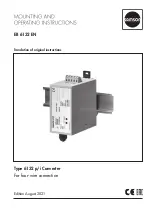
01/02 AWB8230-1413GB
PID control
119
Structure and parameters of the PID controller
PID control active/inactive
DF6 frequency inverters can work in one of the following two
control modes:
• Frequency control active (i.e. PID control inactive)
• PID control active
You can change over between the two modes with PNU A071 (PID
control active/inactive).
In addition, you can switch PID control off by activating a digital
input configured as PID (
a
section “Activate/deactivate PID
control Reset PID and integral component (PIDC)”, page 92).
Frequency control is the standard control method used by many
frequency inverters. A setpoint value is defined by a control unit
(keypad) as an analog voltage or current signal, or through a four
bit wide digital command applied to the control signal terminals.
With PID control, the inverter’s output frequency is controlled by a
control algorithm to ensure that the deviation between the
setpoint and actual value is kept at zero.
Parameters
The following figure illustrates which parameters are effective in
different areas of the PID block diagram. The specified parameters
(such as PNU A072) apply to the frequency inverter’s built-in
keypad:
PNU
Name
Adjustable in RUN mode
Value
Function
WE
Normal
Extended
A071
PID control
active/inactive
–
j
00
PID control is not used (inactive)
00
01
PID control is used (active)
Figure 122: PID control parameters
w: Setpoint
x: Actual value
f
o
: Output frequency
a
Frequency definition through: keypad, fixed frequencies
b
Analog definition through: potentiometer, analog inputs,
current or voltage
a
b
P: PNU A072
I: PNU A073
D: PNU A074
PNU A075
PNU d004
f
O
PNU A075
PNU A01
PNU A075
-1
(PNU A076)
w
PNU F001
+
+
x
–
+
+
0
PNU A013
PNU A011
PNU A012
PNU A014
efesotomasyon.com - Klockner Moeller - inverter
















































